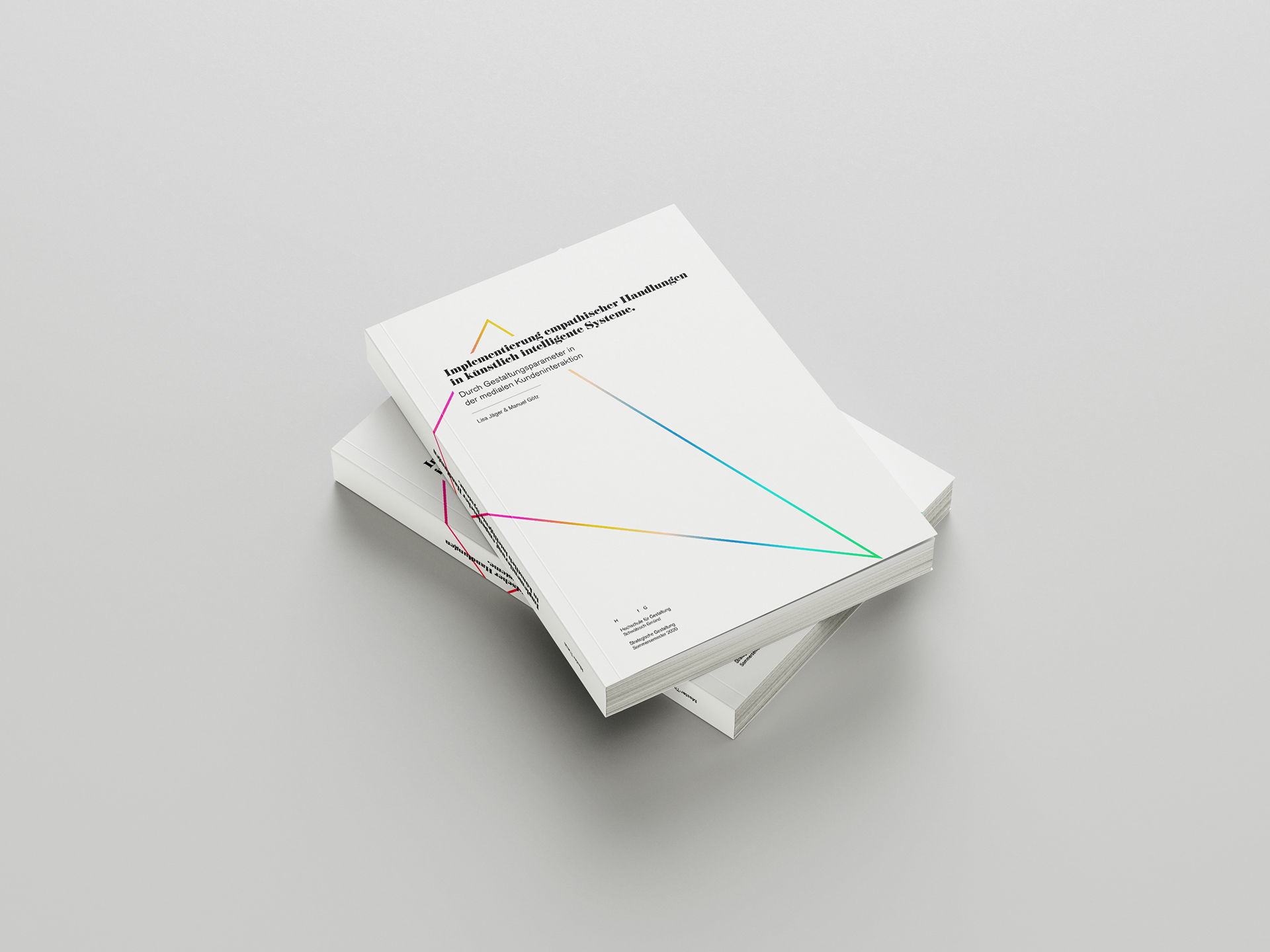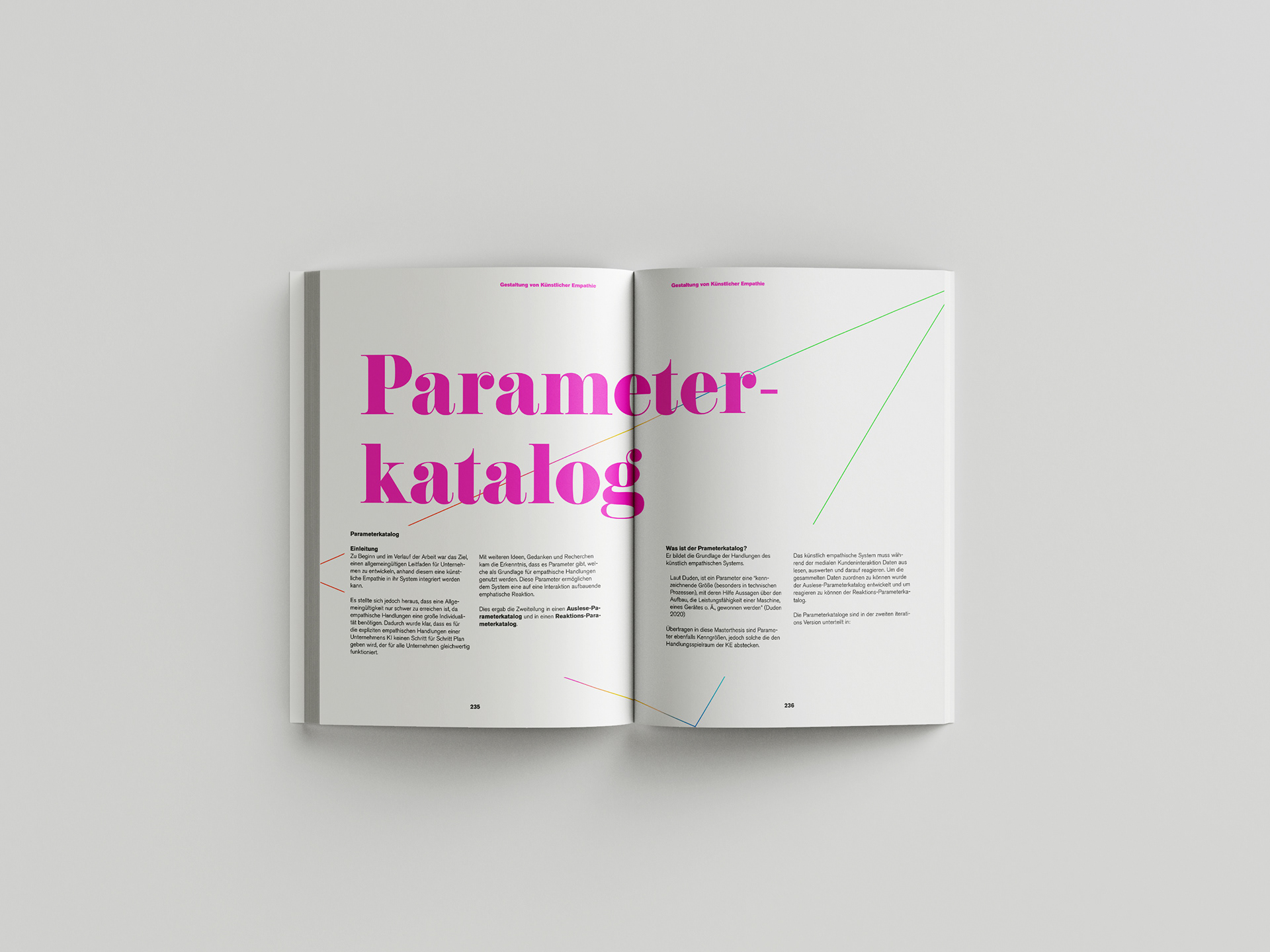Implementing empathic actions in artificially intelligent systems.
Through design parameters in medial customer interaction.
By Manuel Götz & Lisa Jäger
Advances in technology and increasing digitization are placing and challenging new demands on technology and society. Consumer goods are more and more frequently ordered online and many service conversations take place exclusively by phone or chat. Personal interaction with companies is declining steadily. In its place, customers are tending to use a system-based environment. Artificially intelligent systems can provide support here. Nevertheless, the constantly transforming wishes and needs of customers are not yet sufficiently handled.
This master thesis deals with the question, how empathic actions can be implemented in artificially intelligent systems. This will be illustrated by a case study of medial customer interaction. Finally the question will be answered by design and generated solution approaches.
The result results are summarised in two parameter catalogs, which form the basis for the evaluation of the interaction data, as well as the corresponding empathic reaction of the artificially empathic system. In addition, workshops particularly based on this study were developed, in order to train and teach the system.
In the end, the process, the development and the results were documented in a master thesis record titled "Implementation of empathic actions in artificially intelligent systems through design parameters in medial customer interaction".
Parameter catalog
Currently there is no step-by-step guide for explicit empathic actions of an enterprise AI, nor could it apply equally to all enterprises. Through research and analysis, we came to the conclusion that actually there exist parameters wich form the basis for empathic actions. These parameters enable empathic response.
We developed two parameter catalogs, the readout parameter catalog and the response parameter catalog. The differentiation of the two is shown below:
Readout Parameter Catalog
This catalog refers to information, values and mood of the customer. The information collected in advance, the actual state at the beginning of the interaction and the change of emotions during the course of the conversation are analyzed.
This catalog refers to information, values and mood of the customer. The information collected in advance, the actual state at the beginning of the interaction and the change of emotions during the course of the conversation are analyzed.
Reaction parameter catalog
This catalog is a selection of possible reactions for the system. Many companies already use guidelines for behavior in customer interactions. These can be used as a basis for the desired manners within the reaction parameter catalog.
This catalog is a selection of possible reactions for the system. Many companies already use guidelines for behavior in customer interactions. These can be used as a basis for the desired manners within the reaction parameter catalog.
How it works
The collected data is assigned to the given parameters by the artificially intelligent system. The data is linked to the corresponding reaction parameters. According to this, the artificial empathy aligns its actions. On first view, this procedure seems to be strict, as the given parameter assignments are clearly defined. But the customer values are as individual as the customers themselves. As a result, the reaction of the artificial empathy is precisely adapted to the needs of the individual customer.
The collected data is assigned to the given parameters by the artificially intelligent system. The data is linked to the corresponding reaction parameters. According to this, the artificial empathy aligns its actions. On first view, this procedure seems to be strict, as the given parameter assignments are clearly defined. But the customer values are as individual as the customers themselves. As a result, the reaction of the artificial empathy is precisely adapted to the needs of the individual customer.
Workshop
The elaborated parameter catalogs form the basis for the actions of artificially empathic systems. However, this must be learned and trained. We have developed a workshop for this purpose.
Ideal scenarios of a customer interaction are worked out by customers and customer service employees. These are then used to train the artificial empathy. The principle of learning by observation is used here, taking visual, auditory and textual conditions into account.
The goal of the workshop is to generate a high number of different ideal scenarios. To achieve this, the workshop is conducted with both customers and customer service representatives.
Structure
The workshop extends over two days. On day one the current state is determined. The workshop participants describe and record service conversations they have already experienced. On the second day, comments, wishes and inspirations are represented in possible future scenarios.
The workshop extends over two days. On day one the current state is determined. The workshop participants describe and record service conversations they have already experienced. On the second day, comments, wishes and inspirations are represented in possible future scenarios.
The target scenarios for customer interaction are developed and then used as the basis for the artificial empathy. The workshop is led by a workshop leader and an observing external recorder documents the important moments, decisions and discrepancies. These records are used as a basis to discuss the course of the workshop.
Equalization
By using artificial empathic intelligence, we create the equality or egalization through individualized correspondence behavior. The prerequisite for this is to know the behavioral patterns of the individual customers. Parameters such as the information internal to the conversation, the semantics and the emotional situation of the customers hereby form the basis. However, behaviors, behavioral guidelines and habits are based on culture, origin, age and many other factors.
Therefore, background information of the customers is obtained and is included in the analysis. The response parameter catalog provides a basis for the artificial empathy. This way to the user it seems that the artificial empathy reacts appropriately and empathically, although in reality it responds on the basis of the parameter catalog. Furthermore traditions are respected and every customer is treated equally.

Thesis

Parameter catalog




